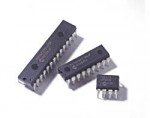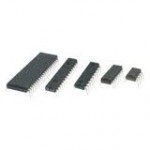Tag: Pic
Robotics – The PICAXE X2 Series
by Sam on Aug.19, 2011, under Electronics, Microcontrollers, Picaxe
The PICAXE ‘X2’ series of microcontrollers, by Revolution Education Ltd., are Rev.Ed.’s advanced series of microcontrollers. The ‘X2’ series of microcontrollers are feature rich, and much much more powerful than Revolution Education Ltd.‘s previous microcontrollers. The ‘X2’ series consists of the 20X2, 28X2, 28X2 lv*, 40X2, and the 40X2 lv*.
The PICAXE ‘X2’ series of microcontrollers have many great new features. Features like almost every pin being configurable as an input or an output. Also the new PICAXE ‘X2’ series of microcontrollers have up to 3 pins that can be individually configured as hardware interrupt pins. The PICAXE ‘X2’ series of microprocessors have many more ADC channels available, support for touch sensing, and they also have an addition of two internal comparators that constantly compare two analogue values.
The PICAXE ‘X2’ series have much higher clock rates than before. Their default frequency is now 8 MHz as opposed to 4 MHz previously. This increase in frequency has greatly improving the processing speed of the PICAXE chips. The frequency also can be as high as 64 MHz!! The PICAXE ‘X2”s also have a much larger RAM, and up to 4 programming slots available on chip. In addition to the four internal programming slots, up to 4 other slots can be used by connecting an external i2c EEPROM chip – per i2c EEPROM connected! Since up to 8 different I2C chips could be used on the same I2C bus, we have a ‘theoretical’ 32 additional program slots available!
The new PICAXE ‘X2’ microcontrollers also have many more great features such as the ability to communicate with Microchip UNI/O EEPROM memory chips, the servo command now operates at 8 or 32 MHz, there is a new new doze low-power command, internal pull-ups, and many more great features. You can download the PICAXE ‘X2’ product briefing as a PDF from the link below.
(*lv = Low Voltage, 1.8v-3v Version)
| Feature | PICAXE Command | 20X2 | 28X2 | 28X2 5v | 28X2 3v | 40X2 | 40X2 5v | 40X2 3v |
| PIC18F series | 14k22 | 25k22 | 2520 | 25k20 | 45k22 | 4520 | 45k20 | |
| (V) Range | 1.8-5.5 | 2.1-5.5 | 4.5-5.5 | 1.8-3.6 | 2.1-5.5 | 4.5-5.5 | 1.8-3.6 | |
| Firmware Version | C.0+ | B.3+ | B.0-B.2 | B.A-B.C | B.3+ | B.0-B.2 | B.A-B.C | |
| Max In/Ex Freq(MHz) | setfreq | 64/na | 16/64 | 8/40* | 16/64 | 16/64 | 8/40* | 16/64 |
| Variables RAM | peek, poke @bptr | 128 | 256 | 256 | 256 | 256 | 256 | 256 |
| Scratchpad RAM | put, get @ptr | 128 | 1024 | 1024 | 1024 | 1024 | 1024 | 1024 |
(* 32MHz [8MHz resonator with x4 PLL] is recommended for programs using serial commands as 40MHz is not an even multiple of 8 and so does not produce valid serial baud rates.)
See these other articles in the ‘Robotics:’ series…
- Robotics – Intro To Microcontrollers
- Robotics – Intro To PICAXE
- Robotics – Microcontroller ? Microprocessor ? or Microchip?
- Robotics – PICAXE M2/X1 Parts
Please leave your comments and sugestions for future articles in the series below. Thank you. 
Robotics – PICAXE M2/X1 Parts
by Sam on Aug.15, 2011, under Electronics, Microcontrollers, Picaxe
Review article: ‘Robotics: Intro to PICAXE’
In my article entitled ‘Robotics: Intro to PICAXE’ I started out with a generalized description of the various PICAXE microcontrollers available from Revolution Education Ltd.. Here I would like to expand slightly and take a bit more In-depth look at the PICAXE microcontrollers. First starting with the ‘Standard Use’ class, then moving on to the ‘Advanced Use’ class after that. Revolution Education Ltd. has changed their previous categories from ‘Education, Standard, Advanced Use’ and combined ‘Education and Standard Use’ into one category. The M2 and X1 microchips are classified as the ‘Standard Use’ class, while the X2 series of microchips are classified as the ‘Advanced Use’ class of microcontrollers.
As of the writhing of this article, you still can purchase several of the older PICAXE microcontrollers, namely: the ‘PICAXE-08M Module’, ‘PICAXE-08 microcontroller’, ‘PICAXE-08 microcontroller (5 pack)’, ‘PICAXE-08 microcontroller (50 pack) [Only available to educational account holders.]’, ‘PICAXE-18X microcontroller’, ‘PICAXE-18X microcontroller (10 pack)’, ‘PICAXE-18M microcontroller (25 pack)’, and the ‘PICAXE-20M microcontroller (22 pack) [Only available to educational account holders.]’. I would suggest however that you stick to the the new PICAXE microcontrollers as they are richer in features, power, and cost LESS in many cases than the older discontinued PICAXE microcontrollers. (I am unsure how long the X1 parts will be available and would suggest moving up to either an X2 part or an M2 part instead)
In the table below you will see the stats for the standard class of PICAXE microcontrollers:
| PICAXE Type | IC Size | Memory | I/O Pins | Outputs | Inputs | ADC | Memory(Data) | Polled Interrupt |
| 08M2 | 8 pin | 2048 | 6* | 6* | 6* | 3 | 256(Shared) | YES |
| 14M2 | 14 pin | 2048 | 11* | 11* | 11* | 7 | 256 | YES |
| 18M2 | 18 pin | 2048 | 16* | 16* | 16* | 10 | 256(Shared) | YES |
| 20M2 | 20 pin | 2048 | 16* | 16* | 16* | 11 | 256 | YES |
| 28X1 | 28 pin | 1000-3200 | 23 | 9-17 | 0-12 | 0-4 | 128+i2c | YES |
| 40X1 | 40 pin | 1000-3200 | 32 | 9-17 | 8-20 | 3-7 | 128+i2c | YES |
(NOTE: the top speed of the M2 Series is 32MHz and the X1 series is 20MHz)
(NOTE: * Input/Output Pins are configurable as either)
Robotics – Intro To Microcontrollers
by Sam on Jun.29, 2011, under Electronics, Microcontrollers, Picaxe

microcontrollers
What is a microcontroller? Well, a microcontroller is a low-cost integrated circuit that contains memory, processing units, and input/output circuitry in a single package. Microcontrollers are purchased ‘blank’ and then programmed with a specific control program. Microcontrollers are usually programmed using the assembler, ‘C’, or Basic programming languages. Once programmed the microcontroller is build into a product to make the product more intelligent and easier to use. A quick look around your environment will provide you with a plethora of examples from computers, T.V.’s, microwave ovens, stoves, and even your car to name just a few. Practically every electronic device these days will contain at least one microcontroller, and sometimes more.
Similar to the microprocessor that powers your personal computer, microcontrollers are a specialized type of integrated circuit or “chip.” They are sometimes thought of as single chip computers because they incorporate circuitry such as timers and memory which are separate components in other microprocessor applications. For robotics they act as the brain of our projects and that of their embedded integrated sub-systems.
One of the most common types of microcontroller are the PIC family of microcontrollers by Microchip. PICAXE microcontrollers are, low-cost, re-programmable microcontrollers by Revolution Education Ltd. The PICAXE microcontroller is a PIC variant, a conventional PIC pre-programmed with a BASIC operating system. A PICAXE chip offers most of the control capabilities of a native PIC processor, but has almost no learning curve, requires no special hardware to program the chip, and is almost as inexpensive as unprogrammed PIC microcontrollers.
The vast majority of microcontoller projects you will find on my site that I will blog about are PICAXE microcontrollers from Revolution Education Ltd. Let us explore the PICAXE micocontoller further in my next post…Robotics – Intro To PICAXE




